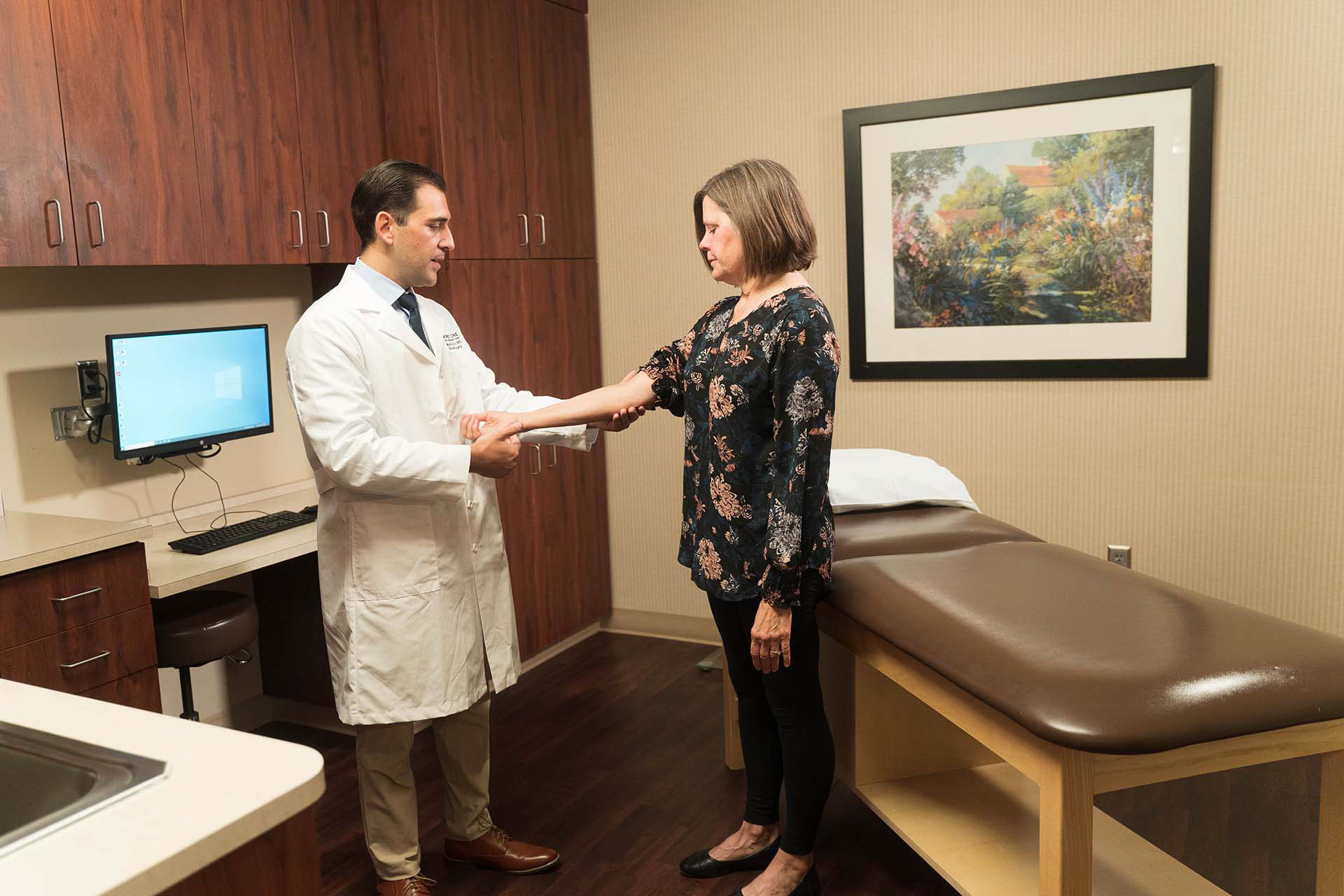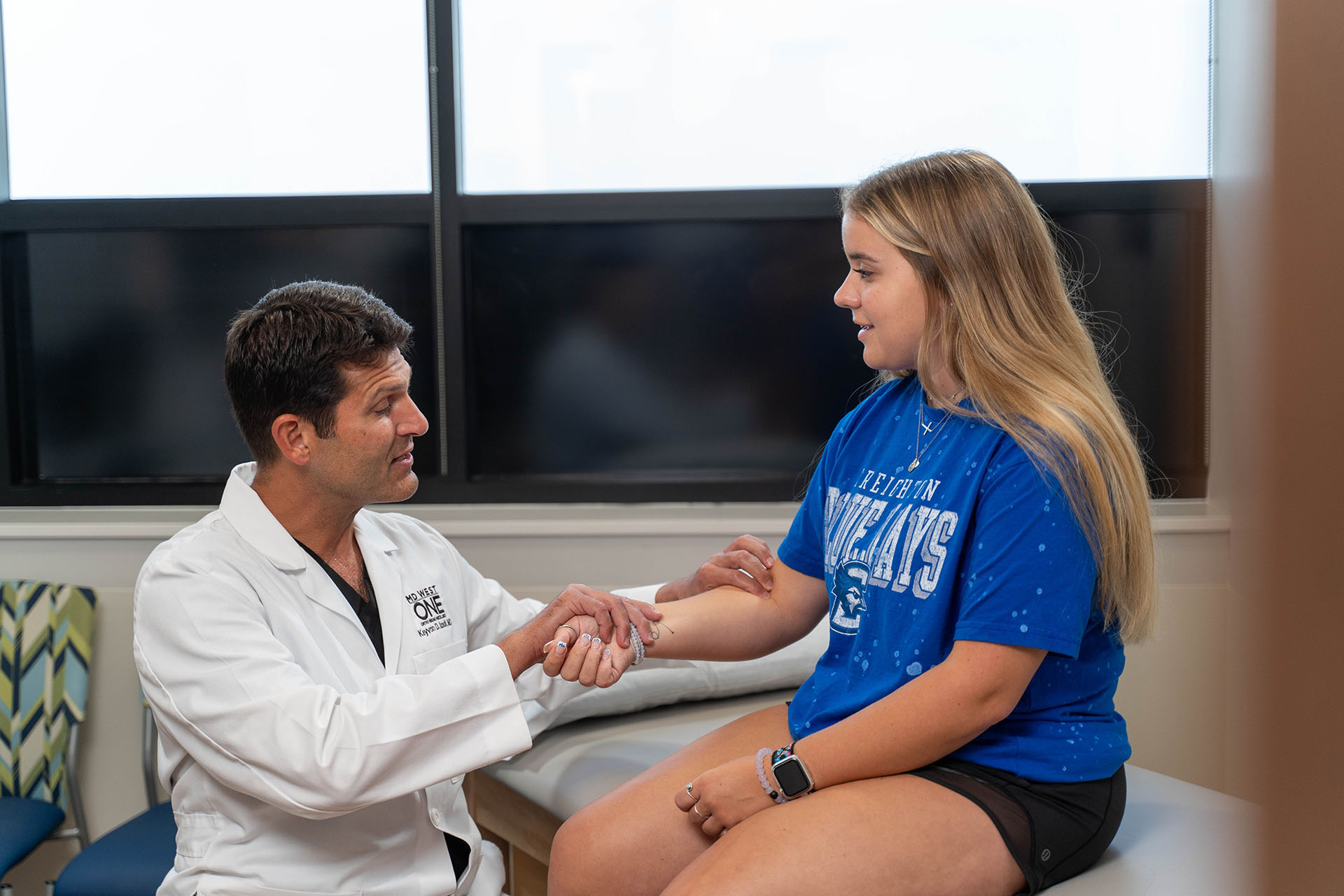Cubital Tunnel Release at the Elbow
A cubital tunnel release at the elbow procedure is used to treat cubital tunnel syndrome. This surgery takes some form of “decompression” or relief of pressure on the nerve.
Why is my doctor recommending a cubital tunnel release at the elbow?
The Omaha Shoulder & Elbow Orthopedic Specialists at MD West ONE can properly recommend if a cubital tunnel release at the elbow is the best course of action based on your symptoms and situation. If you have the following symptoms, you may want to make an appointment with one of our Board Certified Specialists.
- Vague elbow and forearm pain
- Partial or even full numbness in the ring and small fingers
- Clumsiness of the hand and difficulty with grip
- More noticeable symptoms at night or while driving
Generally, cubital tunnel syndrome develops gradually and frequently is present for months before people decide to inform their physician. If the symptoms are severe or do not improve with changes in activity, you will likely be asked to see an orthopedic surgeon. Typically, your initial orthopedic visit will involve learning your history in which you describe your symptoms along with an exam of your wrist and elbow to determine if and where the nerve is being irritated.
What causes cubital tunnel syndrome?
The elbow joint is made up of three bones. The lower end of the arm bone (humerus) joins with the two bones that form the forearm (radius and ulna) to form a hinge joint which allows bending and straightening of the elbow. The elbow allows the hand to be positioned in space for sports, physical labor and normal daily activities. Three major nerves cross the elbow joint, each of which contributes to control and the ability to feel in the hand.
In cubital tunnel syndrome, otherwise known as ulnar nerve compression, the ulnar nerve becomes compressed or irritated and causes numbness, weakness and/or pain in the forearm and hand. The ulnar nerve is also known as the “funny bone” as it travels along the inner (medial) bony part of the elbow and if bumped, can cause pain and brief numbness in the ring and small fingers. This nerve forms from the joining of several nerves in the neck and travels down the inside of the arm and elbow into the forearm toward the ring and small fingers.

Procedure
The procedure is usually carried out as an outpatient in an ambulatory care setting and general anesthesia or local anesthesia supplemented with neuroleptic analgesia is used. There are a few ways to perform the procedure, two possible routes are outlined below.
Simple decompression of the ulnar nerve
The incision is about 4 – 5 inches long centered at the elbow.
The incision may be in back of the elbow over the course of the ulnar nerve or the incision may be curvilinear starting over the intermuscular above the elbow, passing anterior to the elbow and finishing over the flexor carpi ulnaris muscle.
The ulnar nerve is released by cutting the arcuate ligament.
The nerve is followed upward and released at the intermuscular septum.
The nerve is followed below the elbow into the flexor carpi ulnaris and released from any constricting bands.
The incision is then closed with sutures.
Decompression and anterior subcutaneous transposition of the ulnar nerve
The curvilinear incision is used and the nerve released as described above.
The nerve is placed in front of the elbow.
A tunnel is then formed in the fatty tissue beneath the skin with a few absorbable sutures and the incision closed with sutures.
Medial epicondylectomy.
The simple decompression of the nerve is carried out.
The medial epicondyle in front of the nerve is removed with a chisel.
Soft tissues are sutured over the raw bone surface and the incision closed with sutures.
After Surgery
After your surgery, you will arrive in the recovery room where you will be given pain medicine to keep you comfortable. You will remain in the recovery room until you have recovered completely from the anesthesia. Your arm will typically be in a splint.
To help prevent nausea during the first day or so after surgery, you should slowly advance your diet from ice chips to liquids and then to regular meals. The splint is left in place until your first postoperative visit, typically a week or two after the surgery. Showering may begin on the second day as well but care must be taken to keep the splint clean and dry. Several plastic bags with tape sealant may be used. No submersion (bath or swimming) of the elbow may occur for at least four weeks after surgery.
When at home, plan to take it easy as you become increasingly independent and begin to resume your activities. You may walk as much as you like. You may drive a car when authorized by your surgeon; typically, after four to six weeks. When to return to work will depend largely upon your employment duties. Check with your surgeon.

Rehabilitation
Depending on your job duties, you may be able to return to work under certain restrictions- provided you are no longer taking narcotic pain medication (You may wean into over the counter Tylenol, Ibuprofen, or Aleve for your symptoms as tolerated). You will need to avoid heavy lifting and submerging your hand in water until after your post-operative appointment with your surgeon. We suggest you speak with your employer regarding job demands to agree on an expected time of return.
This procedure can be painful to most, so it is expected that you will require narcotic pain medication for the first couple of days. Commonly, patients note an increase in symptoms for approximately the first week after surgery. This will slowly subside over time. You may also experience some bruising and/or swelling. These symptoms may be alleviated through Ibuprofen or Aleve, elevation, and ice. (Please do not take additional Tylenol if you are taking narcotic pain medication; this already has Tylenol).
Your bandages will cover your hand up your arm past your elbow leaving your fingers free for movement. Your digits will be free to perform normal activities of daily living. It is recommended that you keep your digits moving to prevent swelling after surgery; however, we suggest you refrain from heavy lifting until after your post-operative appointment.
At the time of your post-operative appointment, your bandages will be removed. For the next two weeks you will have restrictions that will include no full extension of your operative elbow- your flexion will not be restricted. This restriction will be at your caution and will not require the use of a splint or brace.
Do’s and Don’ts of Recovery
Do NOT overdo it. Early overuse of the arm may compromise your result.
Do NOT lift anything heavier than a glass of water for the first 2 weeks after surgery.
Do ask for assistance. Your physician may be able to recommend an agency or facility if you do not have home support.
Risks and Complications
Cubital tunnel release at the elbow is a relatively safe procedure. However, all surgeries do come with risks or potential complications. Some of the potential risks associated include:
- Complications of ulnar nerve release
- Allergic reactions to medicines
- Bleeding
- Infection
- Injury to the median nerve or nerves that branch off of it
- Weakness and numbness around the hand
- Rarely, injury to another nerve or blood vessel (artery or vein)
- Scar tenderness
Meet MD West ONE's orthopedic specialists and learn more about how they can help with shoulder instability and if an arthroscopic bankart repair is right for you

David C. Buck, MD
Sports Medicine & Total Joint

H. Wesley Cheng, MD
Orthopedic Specialist

Michael Del Core, MD
Upper Extremity Specialist

George Emodi, M.D.
Sports Medicine & Total Joint

Brett W. Fischer, MD
Sports Medicine & Total Joint

Mark Franco, M.D.
Sports Medicine & Total Joint

Daniel L. Gaffney, MD
Hand & Wrist Specialist

Kayvon Izadi, MD
Hand & Wrist Specialist

Darren Keiser, M.D.
Sports Medicine & Total Joint

Justin Makovicka, M.D.
Knee, Shoulder & Sports Medicine

John "Jack" A. McCarthy, MD
Hand & Wrist Specialist

Micheala McCarthy, MD
Hand & Wrist Specialist

Mark Pitner, MD
Sports Medicine & Total Joint

Charles E. Rosipal, MD
Shoulder & Elbow Specialist

Jeffrey J. Tiedeman, MD
Hand & Wrist Specialist

Kimberly A. Turman, MD
Sports Medicine
American Academy of Orthopaedic Surgeons
This article has been written and peer-reviewed by the AAOS Patient and Public Relations Committee and the AAOS Evidence-Based Medicine Committee.
